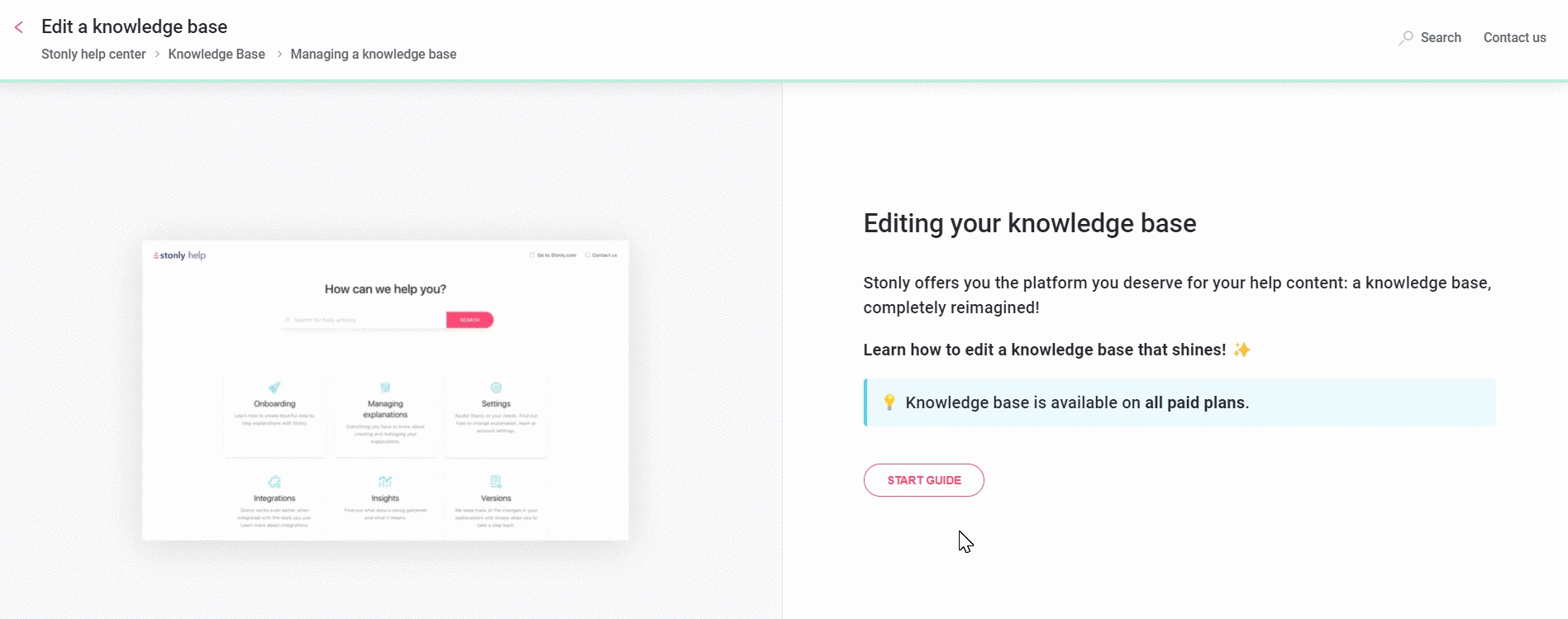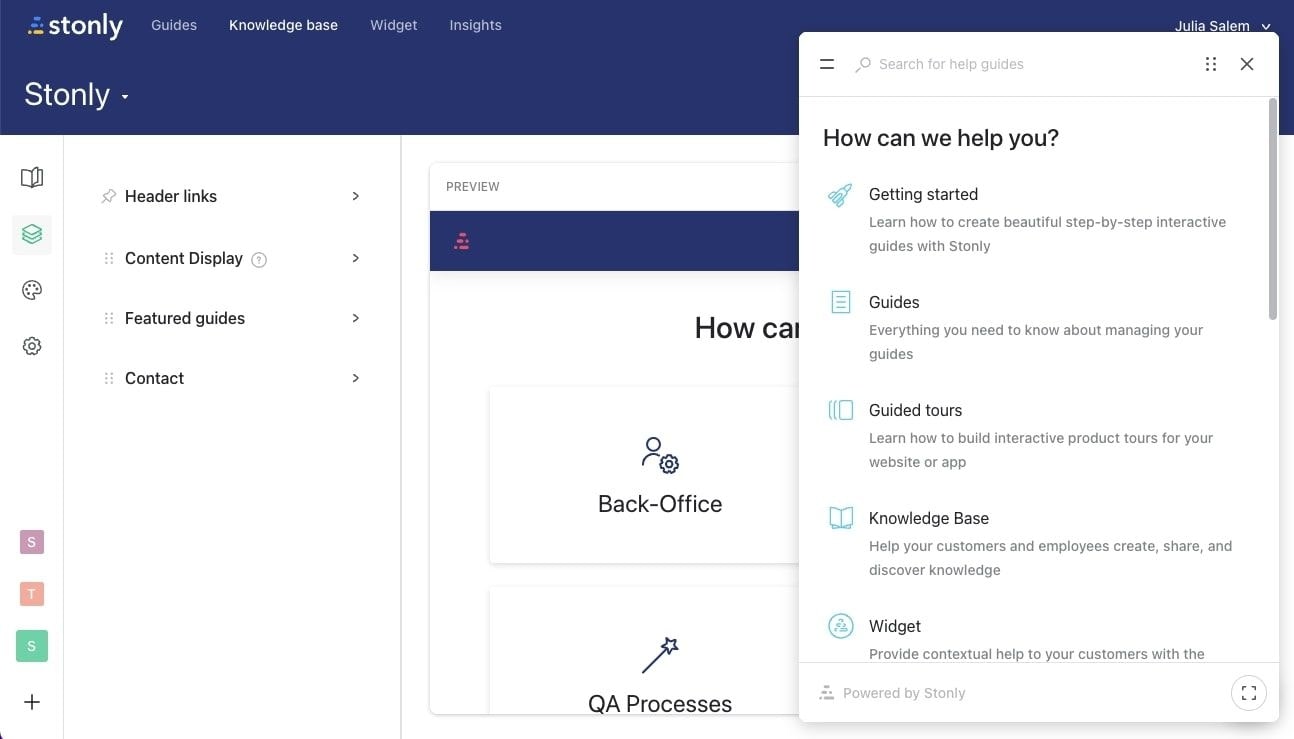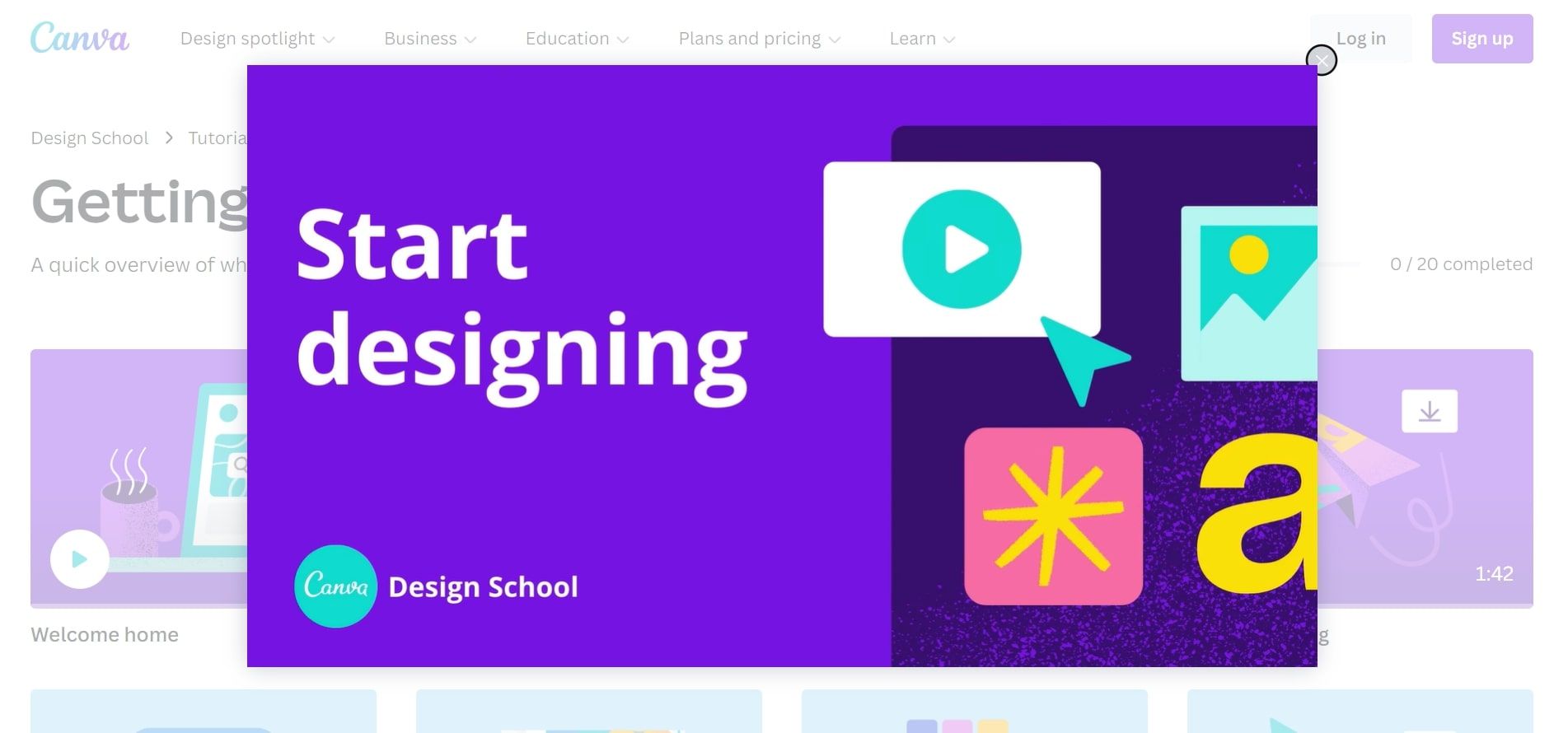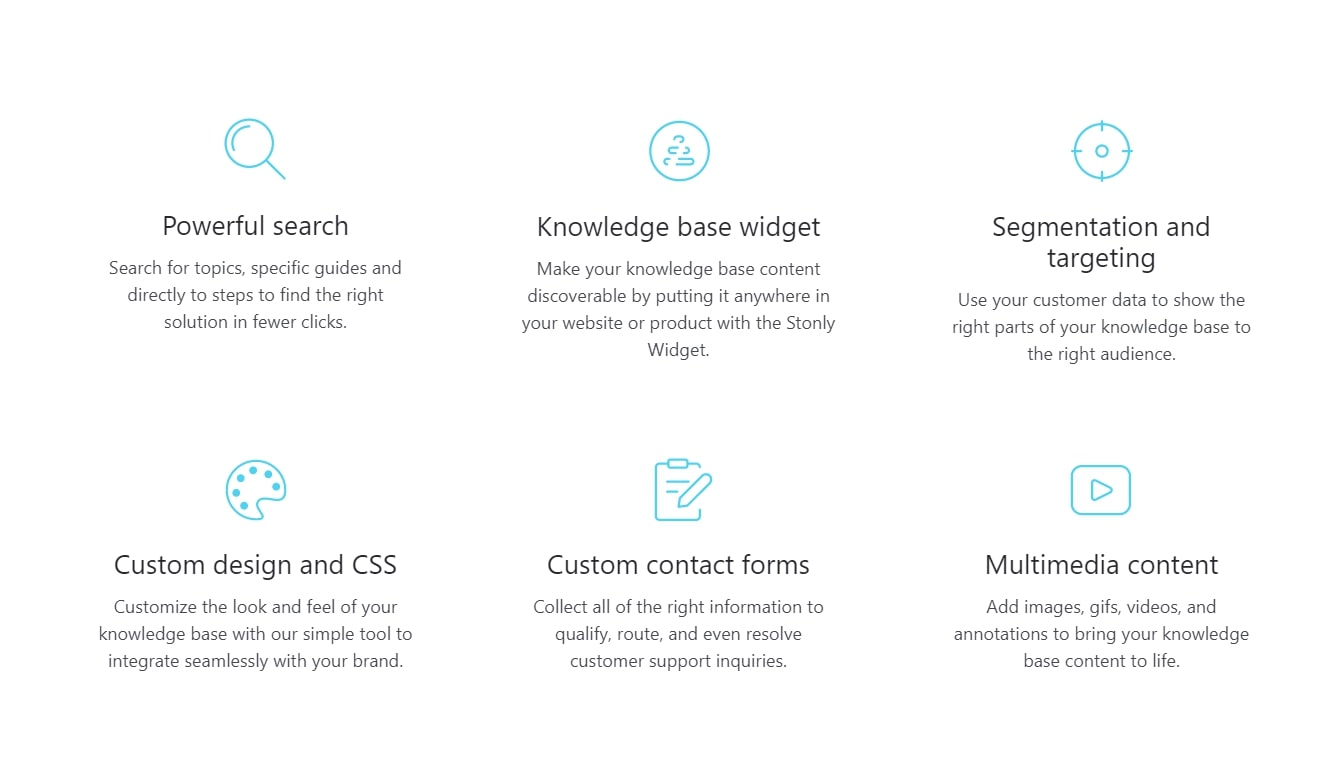The good news: you’ve created a strong knowledge management (KM) program with clearly defined workflows to consistently capture, produce, and share knowledge for employees and customers alike.
The bad news: your workflows are outdated and limit your program’s scalability, your ROI is underwhelming, and a majority of your knowledge remains unused.
Launching a KM program is just the first step. Tracking and upgrading it for the latest knowledge management trends is where the actual heavy lifting happens. If you're struggling with these red flags, your knowledge management strategy needs a facelift.
We’ve done the legwork of curating the nine most promising KM trends for you to enhance your process. Let’s dive right in!
Want to revamp your knowledge management system but can’t find an all-in-one tool to do the heavy lifting?
Your search ends with Stonly.
Sign up for free and try it yourself.
1. Interactive guides to encourage knowledge consumption
How you present knowledge directly impacts how people use it. If your knowledge base looks complicated, confuses the users, or makes them work too hard to access the correct information, nobody will give it a second visit to find answers.
One of the top trends in knowledge management is interactive guides to deliver knowledge as seamlessly as possible. Interactive UIs remove friction from knowledge management and engage with the users to improve the UX and deliver knowledge right when it’s needed.
If you want to embrace this trend, Stonly has just what you need to do it right. You can guide users through a task or process, one step at a time—like this.

Stonly’s interactive guides allow you to:
- Give a customized solution for every user’s specific query
- Offer help whenever and wherever they need it with site-wide widgets
- Create brand-aligned designs to offer a more consistent experience
Here’s what an interactive guide designed with Stonly looks like. At every step, users get multiple options to choose from and find relevant information. The guide combines textual content with annotated screenshots to help users understand and apply any knowledge as easily as possible.

2. Training in the flow of employee work
Organizations are rethinking their KM strategies to embrace the knowledge management trend of creating more employee-centric help. This trend keeps the employee's pain points at the core of the content creation process to produce more relevant and laser-focused knowledge.
KM teams must zoom in on the employees’ needs to find and capture knowledge instead of assuming what might be helpful. It emphasizes interaction with the users to understand their challenges and take a more tailored approach to knowledge management, thus improving the overall employee experience.
This comes into play for knowledge delivery as well. Organizations must make knowledge more easily accessible—often directly within the applications employees use daily. Rather than teaching them everything about how to use software or HR policies, this gives them the exact direction they’re looking for. For example, how to correctly merge two leads in Salesforce or submit a vacation request.
Stonly allows you to make knowledge more accessible by placing it strategically, wherever needed. For example, you can use pop-ups or widgets for in-app guidance to eliminate the need to reach out to someone for clarification, thus making the knowledge flow more seamlessly.

3. Empowering SMEs to create and control knowledge
The increasing involvement of subject matter experts is another knowledge management trend shaping KM initiatives for many organizations. Most teams have a flawed process to capture SMEs' expertise and store it in their knowledge base. They don’t have a well-defined knowledge capture process, which derails their efforts because of inconsistencies and delays.
But this trend enables KM teams to engage with SMEs and get their input effectively. Here's a step-by-step breakdown of the process:
- Set the right expectations: Give your SMEs a head start early to work around their schedules and meet your deadlines. Create smooth workflows to remove any unnecessary bottlenecks.
- Be ready with your guidelines: Prepare a style guide outlining all the content and design basics that SMEs should keep in mind. This helps maintain consistency.
- Templates and examples: Offer a suitable frame of reference for the SMEs to follow. This can be a documentation template or good examples from the past to give them more clarity.
- Quality assurance and approval: Set up an airtight review and approval process to ensure top-notch quality. Check the content against your style guide for a final round of editing before hitting publish.
Organizations can capture crucial information and reduce knowledge loss by embracing this trend. Remember: SMEs can make valuable contributions to your KM program—but only if you make it easy for them.
4. Enhanced search capabilities for ease of navigation and discovery
The search functionality simplifies knowledge discovery. The more search-optimized your knowledge base is, the easier (and more hassle-free) it'll be for users to find relevant information. A search option also removes the pain of navigating a massive knowledge base.
You can adopt this KM trend and make your documentation more search optimized following these easy tips:
- Find keywords by analyzing user queries from the past and intuitively picking words from your existing documentation
- Add relevant tags to every page and map these tags to the right resources for better discoverability
- Create a streamlined content hierarchy through contextual interlinking and callout CTAs for other related pages
- Design faceted navigation with sub-topics clustered under every category
- Track and optimize your documentation for keyword trends
A knowledge management solution like Stonly offers a cutting-edge search engine for teams to make knowledge easily accessible. Let readers find answers to any question in the least number of clicks.
How you’re enabling knowledge discovery is just as important as what knowledge you’re disbursing.
Stonly allows you to simplify this through advanced search capabilities.
Sign up for Stonly today.
5. Mobile apps for on-the-go accessibility and information mobility
On average, mobile users spend 4-5 hours of their day on one or the other apps. In line with this data, mobile apps are becoming a pivotal instrument for offering on-the-go access to knowledge.
Employees and customers want the convenience of finding answers from anywhere—be it on their workstations or a cab ride. A knowledge management mobile app meets this expectation by making knowledge more accessible and consumable.
But here’s the best part: this shift to mobile apps for KM presents an exciting opportunity to make knowledge fun. Teams can:
- Create a game-based setup—like a leaderboard or quiz—incentivizing users to contribute to the KM program
- Leverage microlearning paths to use KM for employee training
- Offer job aids to reinforce knowledge and maximize its ROI
Mobile apps can make knowledge available at users' fingertips and significantly reduce their time finding the correct information.
6. Greater emphasis on visual content to maximize engagement
Visualizing any information with good knowledge graphs and design can make a huge difference. People can process images faster—the human brain only takes 13 milliseconds to register an image—and retain information for longer. These qualities make visual content a good choice for knowledge sharing and management.
While knowledge bases have always been text-heavy, organizations are shifting to more visuals to provide more actionable guidance.
Case in point: Canva’s help center is video-based, with short clips teaching users how to use the design tool effectively. It includes a real-time walkthrough of various features and functions instead of listing the steps in a textual format.

Stonly provides an interactive knowledge base experience to your employees and customers to quickly help them solve their issues and return to their day.
7. Shift towards a democratic approach to knowledge creation
The advances in the world of L&D have remarkably impacted knowledge management, making it more democratic and collective. This trend of democratized knowledge creation encourages a level playing field for all users to contribute to the knowledge management process and simplify decision-making.
Put simply, democratized knowledge promotes a more collaborative approach to KM. All employees have the resources and tools to document their insights in their preferred ways. This helps in minimizing the presence of knowledge silos and creating shared expertise within the organization, promoting a more healthy work environment.
Here’s how you can adopt this trend and democratize KM for your workforce:
- Create an internal knowledge base to centralize all information
- Set up workflows to share knowledge and review new contributions
- Promote a knowledge-sharing culture and reward employees for documenting their experiences
- Audit your KM program to identify gaps and send out requests for contribution
With an all-in-one knowledge management platform like Stonly, you can embrace this trend in no time. Stonly brings you advanced features to work with a team, like versioning and rights management, multiple integrations, and customization options.

8. Laser-focused feedback and analysis for better user experience
Another trend making great waves in the KM space is measuring the impact of your knowledge solutions. Organizations are increasingly looking at analytics to understand user feedback, pinpoint the main issues in knowledge management, and improve content quality.
The main driving force behind this trend is to produce an exceptional user experience backed by data-driven optimization.
You can use these analytics to decode users' search patterns, find and update low-performing pages, and add more relevant content per the search queries. This information can be a game-changer for optimizing your knowledge management system.
9. Use of NLP to optimize knowledge production
Natural Language Processing (NLP) advances constantly make artificial intelligence smarter and more accurate. When combined into a KM process, NLP presents a massive opportunity for organizations to produce and manage limitless knowledge.
Teams can use NLP to strategically organize and use heaps of unstructured data. This means retrieving knowledge passively stored in emails, reports, documents, and other formats is easy.
The growing adoption of AI gives KM teams the power to make more sense of this highly inaccessible and unstructured data and convert it into formal documentation.
Level up your process with these knowledge management trends
Updating your KMS is among the biggest drivers of success. Rethink the design, content, and other elements of your knowledge management portal and process to keep up with the changing user expectations. Emerging trends in the KM space can make your program more future-ready and remove possible areas of friction.
Bookmark this extensive guide to follow the nine most trending knowledge management techniques of 2022. Try a complete KM solution like Stonly to embrace most of these trends and create a power-packed knowledge management program.
Upgrade your knowledge management system to exceed user expectations and skyrocket the ROI with Stonly.
Sign up for free and try it yourself.

